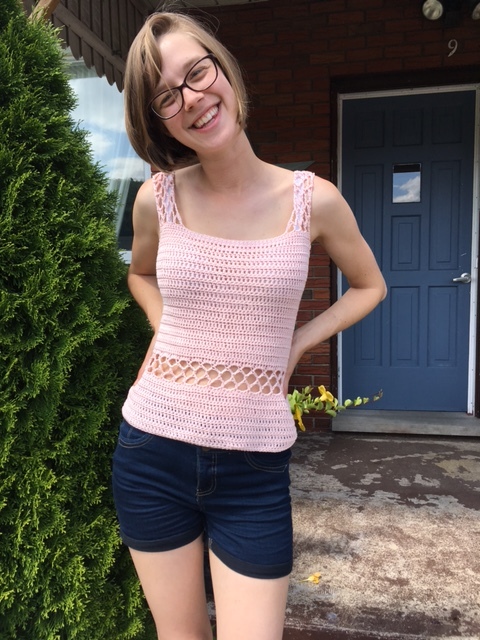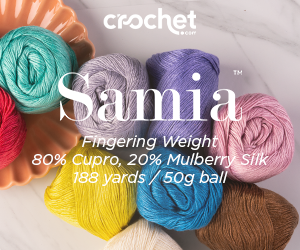Got Gauge?
/I get lots of questions about pattern writing and gauge. I touched on gauge briefly in my How To Write A Crochet Pattern post, but thought it would be a good idea to dive into gauge a bit more. And yep I get it - gauge can be very overwhelming and kind of annoying. But because nobody crochets with the exact same tension and yarn substitions vary, well... Gauge matters. That is really the bottom line.
I've invited my friend Amy to take the reigns and drop some knowledge. She's not just my friend and a badass human being, she's also a super knowledgeable yarnie who spends her days as Creative Director for Universal Yarn. Amy take it away....
Gauge (It’s not a dirty word, I swear!)
If there is one word in crochet and knit terminology that drives stitchers crazy, I think it’s gauge. The word, the concept, the idea: gauge. But it doesn’t have to be so ominous, really!
Briefly, gauge refers to how many stitches you have in your crochet or knit piece of fabric over a given width. Most patterns list gauge over 4 inches or 10 centimeters. To determine your gauge, stitch up a piece of fabric (usually in the stitch pattern called for in your pattern) that is more than 4 inches wide and tall, and measure!
You can find handy-dandy square measuring devices like the one shown here, or you can use a simple ruler or measuring tape. Count the number of stitches in a 4 inch width. In crochet or a bulky weight yarn with knits, this may be half stitches. For example, you may have 9.5 stitches = 4”.
Whatever. Then count the number of rows high over 4 inches – this is your row gauge.
There are a few reasons why gauge is important. First and foremost, by achieving the same gauge listed in the pattern, you can be assured that your item will be the same size as the one pictured. For example: say you see a gorgeous scarf and want to make it and get the pattern. The gauge in the pattern is listed as being 20 sc x 24 rows = 4” / 10 cm using a sport weight (#2 yarn) using a 3.5 mm hook. This breaks down to 5 sc = 1”/2.5 cm (20 sc divided by 4). And say your stitch count is 40 stitches, and the finished width is 8”. This makes sense, because at a gauge of 5 sc = 1”, 40 stitches divided by 5 = 8”. So before you even begin, you have knowledge of what you need to do to achieve the look you want.
A good place to start is always with the same hook size and weight of yarn recommended in the pattern. If the stitch count of the pattern is not too large, personally, I just dive right in and start the project. Work several inches into the project, measure, and assess.
If I was making the scarf I described above, and it measured 8” wide and I was happy with the resulting fabric, I would happily continue with my project. If my theoritical scarf was wider than 8” and I was using the correct weight of yarn, I would adjust hook size and choose a smaller hook in order to get smaller stitches. If my scarf was narrower than 8”, I would go up in size.
Everyone has unique tension on their yarn. And this is something you can learn about yourself and remember as you’re starting a project. Always keep in mind that the hook or needle size recommended in the pattern may not be the size that is right for you to get the listed gauge. It doesn’t mean you’re doing anything wrong! It means that you tension your yarn differently than the person who designed and made the sample in the pattern.
Yarn Ramen happens when you don't check gauge and go to far and have to start over. Avoid Yarn Ramen. Check your Gauge.
When it comes to projects like scarves and shawls and things where a specific size is not that important, gauge is not overly important (don't tell Michele I said that). Though it can be helpful to keep an eye on it because if your stitches are much different than what is listed in a pattern, you may require more or less yarn, and the size of your object will be different than what is listed in the pattern. It may also affect the drape of the project and how the stitch pattern looks and behaves.
Garments are another story. If you are making an item that is going to fit your body, it is absolutely essential to get gauge. Before starting a project in a new yarn with a new pattern, make a swatch, and if at all possible, make sure it’s in whatever stitch pattern is listed in the gauge section of your pattern. Make approximately a 6” x 6” swatch in the stitch pattern and measure out 4” in both stitches (width) and rows (length). If your gauge doesn’t match the pattern, pick a new hook and start again.
I know knitters and crocheters who dread making gauge swatches, and I know those who sincerely enjoy it. I happen to fall somewhere in between. I know it is a necessary step in the process, and I treat it with importance. Though I will not claim to always have fun doing it! But when swatching, it gives you an opportunity to learn about a stitch pattern and the way it behaves with your hook size and yarn before committing to a large project. It’s sort of a “get to know you” with your tools before diving into a long-term relationship. Spending a relatively short period of time doing this can potentially save time, heartache, and precious wasted yarn and sanity in the end. It is the best route to wearing your well fitting garment!
HAPPINESS! Got Gauge and a GREAT FIT!
About Amy: Amy Gunderson is creative director at Universal Yarn by day. By night, she is a freelance designer, tech editor, and graphic artist specializing in crochet charts and other knit & crochet related graphics. See Amy's Ravelry profile page here.



























